![]()
![]()
![]()
Use LEFT and RIGHT arrow keys to navigate between flashcards;
Use UP and DOWN arrow keys to flip the card;
H to show hint;
A reads text to speech;
81 Cards in this Set
- Front
- Back
|
3 ways to classify suture:
|
degradation behavior (absorbable vs non absorbable), composition (natural vs synthetic), structure (mono vs multifilament)
|
|
|
define absorbable suture:
|
suture undergoes degradation & loss of tensile strength within 60 days
|
|
|
How are natural absorbable materials degraded?
|
Proteolytic enzymes
|
|
|
How are synthetic absorbable materials degraded?
|
Nonenzymatic hydrolysis of ester bonds (independent of inflammation) +/- phagocytosis
|
|
|
What are the advantages & disadvantages of multifilament suture?
|
Good handling, good knot tying, good knot security but increased capillarity, increased drag
|
|
|
What are the advantages & disadvantages of monofilament suture?
|
Less tissue drag, less reaction, less risk of infection, less risk of prettied loops to collapse but higher stiffness, greater memory, poorer handling (low coefficient of friction), less knot security
|
|
|
What affects suture flexibility?
|
torsional stiffness & diameter
|
|
|
What is suture elasticity?
|
Capability of a material to undergo elastic deformation under tension & return to its original length after stretching
|
|
|
Define coefficient of friction:
|
measure of the slipperiness of a suture that affects the tendency of the knot to loosen after it has been tied
|
|
|
What is tissue drag?
|
Resistance & subsequent trauma when pulled through tissue
|
|
|
Define capillarity:
|
process by which bacteria and fluid are carried into the interstices of a multifilament suture material
|
|
|
Define tensile strength:
|
force that the untied suture strand can withstand before it breaks when forces is applied in the direction of its length
|
|
|
Define knot holding capacity:
|
maximum load to failure when tension is applied to knotted suture material
|
|
|
Define relative knot security:
|
RKS (%) = (knot holding capacity/ tensile strength) x 100
|
|
|
What is the difference between a regular cutting needle and a reverse cutting needle?
|
Both have triangular cross-sectional area but the regular cutting has the sharp cutting edge on inner curvature of the needle point & shaft and reverse cutting has cutting edge on outer curvature of the needle point & shaft
|
|
|
What is the disadvantage of the regular cutting needle?
|
Placement of cutting surface can lead to cut out of tissue
|
|
|
What is a taper cut needle?
|
Combination of reverse cutting with a round shaft to limit cut or enlarge hole when needle passes through tissue
|
|
|
What is a spatula needle?
|
Flat on top and bottom of needle with cutting on the side
|
|
|
What is a blunt point needle?
|
Rounded, blunt point that can penetrate soft or friable tissues without cutting them
|
|
|
What is loop security?
|
Capability to maintain a tight suture loop as a knot is tied
|
|
|
What is knot security?
|
Effectiveness of the knot at resisting slippage when load is applied
|
|
|
What does knot security depend on?
|
Structural configuration of the knot and type of suture material
|
|
|
What characteristics of suture affect knot security?
|
Memory, coefficient of friction
|
|
|
What are the advantages of continuous patterns?
|
Smaller volume of suture material, decreased surgery time, more even distribution of tension, better holding power against stress, tighter seal of skin & hollow viscera
|
|
|
What are the advantages of interrupted patterns?
|
Increased security (if 1 suture fails all will not fail), precise reconstruction of irregular margins, precise control of tension, less interference with blood supply, no purse string effect on hollow viscera
|
|
|
What are the advantages & disadvantages of intradermal patterns?
|
No suture removal, no skin irritation, no suture track infections, excellent cosmesis but increased surgery time, less security than skin closure
|
|
|
What suture materials are best for gi surgery?
|
Absorbable synthetic (polyglycolic acid, polyglactin 910, polydioxanone)
|
|
|
What suture materials are best for urinary surgery?
|
Absorbable synthetic (if no urine exposure then poliglecapprone, if risk of urine exposure then polyglyconate or polydioxanone)
|
|
|
What is the least thrombogenic suture?
|
Polypropylene
|
|
|
TA: how many rows of staples?
|
2 (green, blue) 3 (white)
|
|
|
TA: material of staples?
|
Titanium
|
|
|
TA: types of stapler units?
|
Reuseable stainless steel OR disposable reloadable
|
|
|
TA: cartridges for reuseable stainless steel stapler?
|
30, 55, 90 mm
|
|
|
TA: cartridges for disposable reloadable stapler?
|
30, 45, 60, 90
|
|
|
TA: staple types and dimensions:
|
white crown width 3.0 leg length 2.5 closed height 1.0mm; blue crown width 4.0 leg length 3.5 closed height 1.5; green crown width 4.0 leg length 4.8 closed height 2.0mm
|
|
|
GIA: types of stapler units:
|
reusable stainless steel, disposable reloadable
|
|
|
GIA: rows of staples:
|
4
|
|
|
GIA: staple material:
|
stainless steel or titanium
|
|
|
GIA: staple dimensions:
|
green crown width 3.0 leg length 4.8 closed height 2.0mm blue crown width 3.0 leg length 3.8 closed height 1.5mm
|
|
|
ILA: type of stapler units:
|
reuseable stainless steel
|
|
|
ILA: row of staples:
|
4
|
|
|
ILA: staple material:
|
stainless steel, titanium
|
|
|
ILA: staple dimensions:
|
green crown width 3.0 leg length 4.8 closed height 2.0mm blue crown width 3.0 leg length 3.8 closed height 1.5mm
|
|
|
LDS: size of staples:
|
regular 5.8 wide x 5.2 tall 5.3 closure width 6.35 mm distance between staples or wide 8.0 wide x 7.2 tall 7.3 closure width 9.53 distance between staples
|
|
|
What thickness does LDS compress tissue to?
|
0.75mm
|
|
|
What is the ratio of ligating clip to vessel diameter?
|
The diameter of the vessel should be 1/3-2/3 the size of the clip
|
|
|
Surgical gut: filament, absorption, tensile strength:
|
multifilament, 2 phases: 1) molecular bonds cleaved by acid hydrolytic & collagenlytic activity 2) digestion & absorption by proteolytic enzymes; mono >14 days tensile strength, multi retains strength for 14-28 days
|
|
|
Polyglactin 910: trade name, filament, absorption, tensile strength:
|
vicryl, braided multifilament, 56-70 days by hydrolysis, 25% reduction in strength at 14 days, 50% at 21 days, 100% at 35 days
|
|
|
Polyglycolic acid: trade name, filament, absorption, tensile strength:
|
dexon, braided multifilament, 60-90 days by hydrolysis(rapid in alkaline, degradation products antibacterial), strength reduced by 35% at day 14, 65% at day 21
|
|
|
Braided lactomer: trade name, filament, absorption, tensile strength:
|
polysorb, braided multifilament, 56-70 days by resorption, superior to polyglactin 910 strength is 80% of original at day 14 and 30% of original at day 21
|
|
|
Glycomer 631: trade name, filament, absorption, tensile strength:
|
biosyn, monofilament, 90-100 day resorption time, 75% of original at day 14 and 40% of original at day 21
|
|
|
Polyglytone 6211: trade name, filament, absorption, tensile strength:
|
caprosyn, monofilament, complete resorption by day 56, all strength lost by day 21
|
|
|
Polydioxanone: trade name, filament, absorption, tensile strength:
|
PDS, monofilament, 180 day hydrolysis, 25% reduction by day 14, 30% reduction by day 28, 50% reduction by day 42
|
|
|
Polyglyconate/ maxon: filament, absorption, tensile strength:
|
monofilament, start hydrolysis day 60 end in 180 days, reduced strength by 25% at day 14, 50% at day 28 and 75% at day 42
|
|
|
Polyglyconate/ monosyn: filament, absorption, tensile strength:
|
monofilament, resorption in 60-90 days, strength reduced by 30% at day 7, 50% at day 14, 80% at day 21
|
|
|
Poliglecaprone: trade name, filament, absorption, tensile strength:
|
monocryl, monofilament, hydrolysis in 90-120 days, strength reduced by 50% at day 7, 75% at day 14, 100% day 21
|
|
|
Nylon: trade name, filament, tensile strength:
|
dafilon, mono or multifilament, mono loses 30% strength by 2 yrs, multi has no strength after 6 mo
|
|
|
Polycaprolactam: trade name, filament, tensile strength:
|
supramid, multifilament, no tensile strength after 6 mo
|
|
|
Polyester: trade name, filament, tensile strength:
|
ethibond, mono or multifilament, very high sustained tensile strength
|
|
|
Ultra high MW polyethylene: trade name, filament, tensile strength:
|
fiberwire, multifilament, superior strength & less elongation than polyester
|
|
|
Polypropylene: trade name, filament, tensile strength:
|
prolene, monofilament, moderate tensile strength
|
|
|
Polybutester:
|
novafil, non-absorbable monofilament
|
|
|
Silk:
|
braided, natural, multifilament, loses 80% tensile strength in 8 days
|
|
|
Use of 4S modified roeder knot:
|
sliding knot for extracorporeal laparoscopically placed suture
|
|
|
Appropriate suture and size for 4S roeder knot:
|
polydioxanone, polyglyconate better than polyglactin 910, polyglycolic acid. Use size 1 or 2
|
|
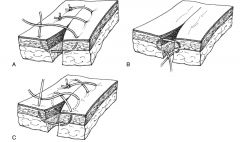
|

|
|
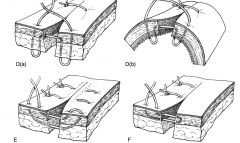
|

|
|
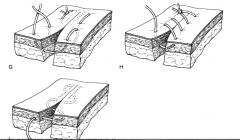
|

|
|
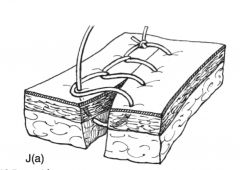
|

|
|
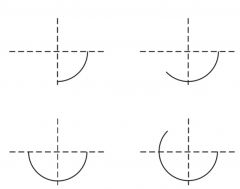
|
1/4
3/8 1/2 5/8 |
|
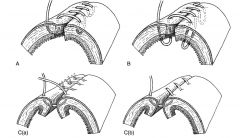
|

|
|

|

|
|
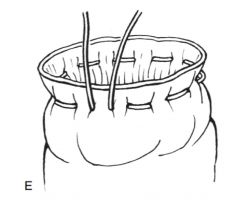
|

|
|
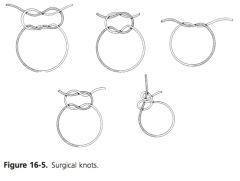
|
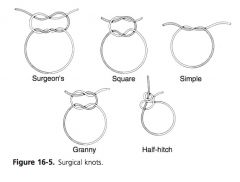
|
|
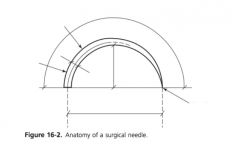
|
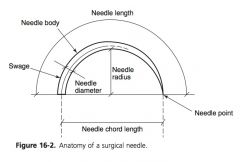
|
|
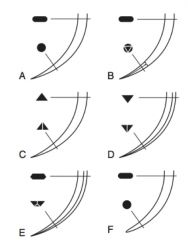
|

|
|
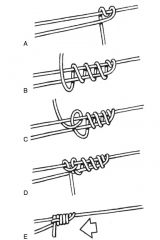
|

|
|
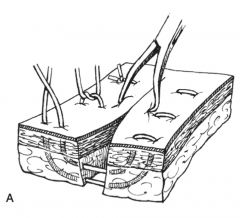
|

|
|
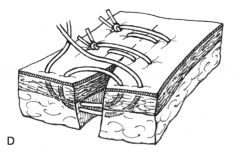
|

|
|
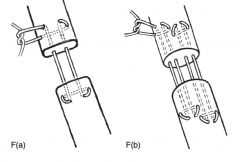
|

|
|
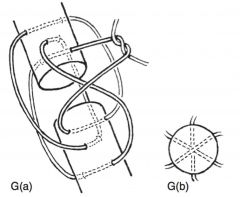
|

|

